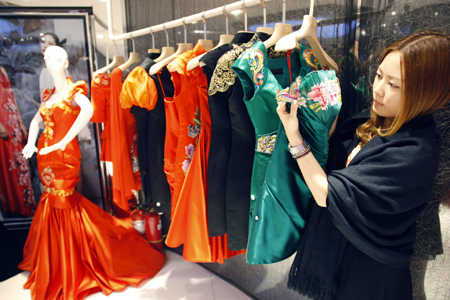Patience is a virtue for haute couture
 0 Comment(s)
0 Comment(s) Print
Print E-mail
Chinadaily.com.cn, September 2, 2011
E-mail
Chinadaily.com.cn, September 2, 2011
 |
|
A customer looks over Hua Fu dresses in a NE Tiger Fashion Co shop.[China Daily] |
Domestic high-end clothing manufacturers have a long way to go to become luxury brands, but this is the best time for luxury brands to develop in China, experts said.
Luxury brands need historical and cultural grounding and huge investment before making gains, said Zhou Ting, executive director of the research center for luxury goods and services at the University of International Business and Economics in Beijing.
"Manufacturers cannot make a profit in high-end business right away, and they have to be in the business for a long time," Zhou said. "A desire for instant success can be an obstacle to luxury brands."
Zhou said most high-end clothing makers adopt customizing to operate their business, but they face heavy pressure to make a profit.
Guo Pei, one of the first haute couture designers in China, said she needs to pay at least 60,000 yuan ($9,400) in labor costs to customize dresses priced at 100,000 yuan.
Add to that the cost of fabric, the designer and miscellaneous other things, Guo said, and there is not much room for profit.
Ma Yanli, a former Chinese supermodel who founded a high-end, customized clothing brand in 2005, has had to expand her business to medium income consumers.
Design is another problem domestic brands have to deal with, Zhou said.
Although Chinese designers are gaining recognition in international fashion, most of them are foreign citizens and got the best fashion education in the West, such as Vera Wang and Jason Wu.
"Local designers are still far from the international top," Zhou said. "And domestic manufacturers can only use Chinese elements, because of their designers."
Most domestic manufacturers play the Chinese element card and during the China International Fashion Week Spring and Summer 2011 in November 2010, Chinese elements were seen everywhere.
Chinese red, ink painting and clothing techniques from ethnic groups are all used, but some business insiders are not fans of the trend.
"I have never gone to the fashion week, because Chinese elements are everywhere," said Zhang Chi, a Chinese fashion designer who owns his own studio in London. "All brands employ the Chinese style, and there are no real fashion designers."
Nevertheless, now is the best time for domestic manufactures that are trying to build luxury brands.
According to McKinsey & Company, China's luxury market is increasing despite the international financial crises, and the market grew by 16 percent year-on-year in 2009, a percentage that far outdoes other luxury markets.
"It's weird that we started to make a profit in 2008, when the global economy declined," said Zhang Zhifeng, chairman of NE Tiger Fashion Co.
The large market supports domestic brands to develop quickly, Zhou Ting said, but the brands need to develop internationally to be real luxury brands. "Only by getting recognition in the world does a brand become a true luxury brand."
Shanghai Tang, thought of as the first successful luxury clothing brand in China, was purchased in 2000 by Richemont Group, the world's second-largest luxury group by turnover. The Chinese dress business is operated according to international rules by an international team.
"Domestic brands also need international teams to build the luxury brands," Zhou said.






Go to Forum >>0 Comment(s)